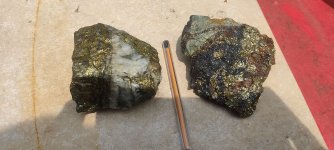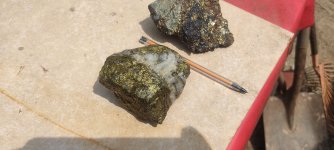Navigation
Install the app
How to install the app on iOS
Follow along with the video below to see how to install our site as a web app on your home screen.
Note: This feature may not be available in some browsers.
More options
You are using an out of date browser. It may not display this or other websites correctly.
You should upgrade or use an alternative browser.
You should upgrade or use an alternative browser.
Gold or Pyrite
- Thread starter alloy_II
- Start date
EKG
Full Member
- Mar 19, 2017
- 174
- 267
- Detector(s) used
- Minelab Fisher Jeohunter
- Primary Interest:
- All Treasure Hunting
It looks like gold to me both of your photos.
Fool's Gold, otherwise known as Pyrite or Iron Sulfide(FeS2), is probably one of the most well-known minerals on the planet. It enjoys a special place in the heart of novice rock hounds, as its similarity to gold has garnered this mineral its nickname. Pyrite has a brassy-golden luster that has fooled tons of people. Even when polished, the masse of its gold-like luster tends to overshadow its crystal structure.
Pyrite is a very hard mineral, ranking at six on the Mohs Hardness Scale. It is abundant in the Earth’s crust in the form of large crystals, and the deposits can be found all over the world. Pyrite has been used since ancient times in jewelry, in the form of intaglio engravings and as an ornamental stone. It also is used as an industrial mineral, as an ore of iron and as a source of sulfur.
Perhaps the most well-known use of pyrite lies in its confusion with gold. It is striking to the untrained eye, which has resulted in it being referred to as ‘fool’s gold’. Many miners throughout the world have mistaken this mineral for the real thing, especially during the California Gold Rush in the mid-19th century.
The aliases of this mineral, such as iron glance, brass glance and cat’s-eye are centered around its remarkable brilliance. Pyrite is strongly metallic and was once a major ore of iron. Its composition of iron and sulfur together gives it a strong resemblance to gold. Its ability to form perfect cubic crystals and occasionally pyritohedrons and the fact that gold is rarely visible in quartz veins only add to the illusion.
While fooled by the looks of this sulfide, be sure to not confuse it with the real thing, or you may find yourself with a pocketful of pyrite, laughing at yourself.
Fool's Gold, otherwise known as Pyrite or Iron Sulfide(FeS2), is probably one of the most well-known minerals on the planet. It enjoys a special place in the heart of novice rock hounds, as its similarity to gold has garnered this mineral its nickname. Pyrite has a brassy-golden luster that has fooled tons of people. Even when polished, the masse of its gold-like luster tends to overshadow its crystal structure.
Pyrite is a very hard mineral, ranking at six on the Mohs Hardness Scale. It is abundant in the Earth’s crust in the form of large crystals, and the deposits can be found all over the world. Pyrite has been used since ancient times in jewelry, in the form of intaglio engravings and as an ornamental stone. It also is used as an industrial mineral, as an ore of iron and as a source of sulfur.
Perhaps the most well-known use of pyrite lies in its confusion with gold. It is striking to the untrained eye, which has resulted in it being referred to as ‘fool’s gold’. Many miners throughout the world have mistaken this mineral for the real thing, especially during the California Gold Rush in the mid-19th century.
The aliases of this mineral, such as iron glance, brass glance and cat’s-eye are centered around its remarkable brilliance. Pyrite is strongly metallic and was once a major ore of iron. Its composition of iron and sulfur together gives it a strong resemblance to gold. Its ability to form perfect cubic crystals and occasionally pyritohedrons and the fact that gold is rarely visible in quartz veins only add to the illusion.
While fooled by the looks of this sulfide, be sure to not confuse it with the real thing, or you may find yourself with a pocketful of pyrite, laughing at yourself.
Attachments
arizau
Silver Member
- May 2, 2014
- 2,518
- 3,947
- Detector(s) used
- Beach High Banker, Sweep Jig, Whippet Dry Washer, Lobo ST, 1/2 width 2 tray Gold Cube, numerous pans, rocker box, and home made fluid bed and stream sluices.
- Primary Interest:
- Prospecting
View your samples while shaded from direct light. Anything but gold loses it's gold appearance under indirect lighting.Expecting this sample to arrive in the mail within the next week or so for testing,
Personally I think think the samples are pyrite, what say you.
Vial sample top image definitely looks like pyrite, the quartz possibly gold.
View attachment 2079213
View attachment 2079211
alloy_II
Hero Member
- Dec 24, 2021
- 630
- 1,028
- Thread starter
- #4
Not my samples a buddy from BC thinks he's hit the mother lode, I'm doubtful. But will know better once the samples arrive in the mail for further testing.It looks like gold to me both of your photos.
Fool's Gold, otherwise known as Pyrite or Iron Sulfide(FeS2), is probably one of the most well-known minerals on the planet. It enjoys a special place in the heart of novice rock hounds, as its similarity to gold has garnered this mineral its nickname. Pyrite has a brassy-golden luster that has fooled tons of people. Even when polished, the masse of its gold-like luster tends to overshadow its crystal structure.
Pyrite is a very hard mineral, ranking at six on the Mohs Hardness Scale. It is abundant in the Earth’s crust in the form of large crystals, and the deposits can be found all over the world. Pyrite has been used since ancient times in jewelry, in the form of intaglio engravings and as an ornamental stone. It also is used as an industrial mineral, as an ore of iron and as a source of sulfur.
Perhaps the most well-known use of pyrite lies in its confusion with gold. It is striking to the untrained eye, which has resulted in it being referred to as ‘fool’s gold’. Many miners throughout the world have mistaken this mineral for the real thing, especially during the California Gold Rush in the mid-19th century.
The aliases of this mineral, such as iron glance, brass glance and cat’s-eye are centered around its remarkable brilliance. Pyrite is strongly metallic and was once a major ore of iron. Its composition of iron and sulfur together gives it a strong resemblance to gold. Its ability to form perfect cubic crystals and occasionally pyritohedrons and the fact that gold is rarely visible in quartz veins only add to the illusion.
While fooled by the looks of this sulfide, be sure to not confuse it with the real thing, or you may find yourself with a pocketful of pyrite, laughing at yourself.
Top Member Reactions
-
 3343
3343 -
 1971
1971 -
 1930
1930 -
 1181
1181 -
 1098
1098 -
 897
897 -
 810
810 -
 805
805 -
 798
798 -
 792
792 -
 774
774 -
 531
531 -
 494
494 -
 460
460 -
 443
443 -
 429
429 -
 424
424 -
 423
423 -
E
414
-
 386
386
Users who are viewing this thread
Total: 2 (members: 0, guests: 2)






